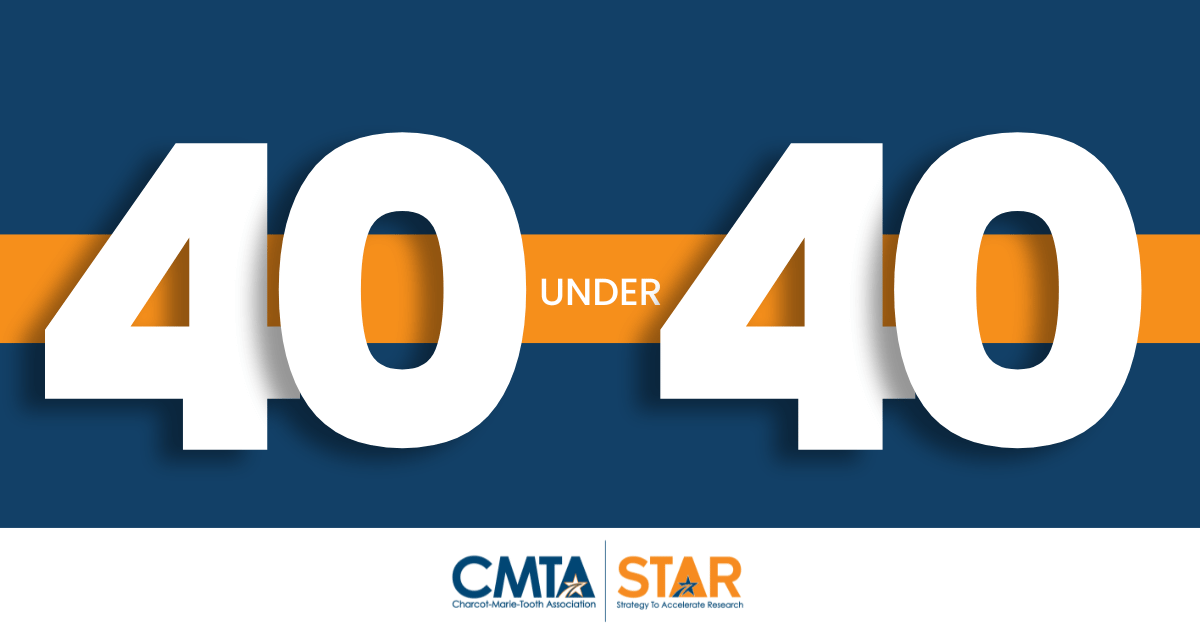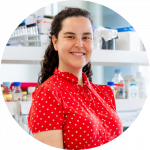
When CMTA implemented its Strategy to Accelerate Research in 2008, a key component was enlisting investigators and scientists from an international body of the world’s most accomplished medical pioneers.
Our integrated team of top scientists and industry partners working together toward a common goal is what sets the CMTA-STAR program apart and what drives its remarkable success.
Today, the next generation of researchers—our 40 Under 40—is making significant strides in reshaping our comprehension of CMT. Their passion, expertise and relentless pursuit of scientific breakthroughs and high-quality patient care play a pivotal role in driving progress towards effective treatments and, ultimately, a more promising future for the CMT community.
Trained by their elders, these young individuals are pushing the boundaries of knowledge and innovation across various CMT subtypes, offering new prospects and hope to those who live with CMT.
In this article, we proudly introduce 40 of the young researchers fearlessly leading the charge in CMT research, highlighting their remarkable contributions and inspiring everyone to unite in the fight against the disease.

Elena Abati, MD
Neurologist, Neurology Unit, Fondazione IRCCS Ca’ Granda Ospedale Maggiore Policlinico, Milan, Italy; D.Phil Student, Translational Medicine, Neural Stem Cell Lab, Department of Pathophysiology and Transplantation (DEPT), University of Milan, Milan, Italy
Dr. Abati’s research focuses on the development of a combined RNA interference and gene therapy therapeutic approach targeting the MFN2 gene for the treatment of CMT2A. Her team tested this approach both on in vitro and in vivo models, showing molecular correction of the defect and therapeutic efficacy. She also worked on the description of novel pathogenic variants of MFN2 and on the phenotypical and genetic characterization of different families and cohorts of patients with CMT. Her team is currently starting a project on serum biomarkers in CMT.
Read more
Aljwhara Ahmed Alangary, MSc, BSc
Faculty member at College of Medicine, King Saud University, Riyadh, Saudi Arabia. Doctoral Fellow at Queen Square Centre for Neuromuscular Diseases, UCL, London, UK.
Alangary has been a qualified physiotherapist since 2015. She obtained her MSc in neuromuscular diseases from UCL Queen Square Institute of Neurology, London, UK in 2018 and is currently a doctoral fellow at the same institute. Her research focuses on neuromuscular rehabilitation, specifically muscle structure, function and gait patterns in people with distal hereditary motor neuropathy (DHMN).
Read more
Paola Alberti, MD, PhD
Assistant Professor (Human Anatomy) at University of Milano-Bicocca (Milan, Italy) and Consultant Neurologist at Fondazione IRCSS San Gerardo dei Tintori (Monza, Italy)
Dr. Alberti has robust clinical and preclinical expertise on peripheral neuropathies (PNs), especially chemotherapy-induced PNs. She recently received a grant to coordinate a preclinical project that will allow her to devise the role of ion channels/transporter in axonal damage development to ameliorate quality of life of patients affected by PNs. During the last year, she conducted a detailed systematic review on potentially toxic medications for CMT patients that was published on the prestigious Journal of the Peripheral Nervous System (https://onlinelibrary.wiley.com/doi/10.1111/jns.12566).
Read more
Peter Arthur-Farraj, MD, PhD
Clinician Scientist, University of Cambridge, UK
Dr. Arthur-Farraj is a neurologist and neuroscientist with an interest in neuromuscular disorders and nerve repair. His research focuses on how Schwann cells transform after injury into “repair” Schwann cells to help promote both nerve cell survival and regrowth. His lab uses a variety of experimental techniques to study nerve repair, including transgenic mice, live imaging in larval zebrafish, mouse and human cell culture, next generation sequencing and gene therapy.
Read more
Kayla Cornett, PhD, MSc, BHK
Postdoctoral Fellow, University of Sydney and Children’s Hospital at Westmead
Cornett’s research focuses on developing and validating accurate clinical outcome measures and training evaluators in order to establish and maintain clinical trial readiness for children with CMT. The highest quality trials make discovery of effective interventions more likely for patients with CMT. As CMT is progressive, it is critical to intervene as early as possible prior to significant deterioration. Preparing for pediatric trials will ensure rapid site activation, efficient conduct and meaningful outcomes.
Read more
Andrea Cortese, MD, PhD
Consultant Neurologist and MRC Clinician Scientist
Dr. Cortese is a neurologist and MRC clinician scientist at the University College London, UK and University of Pavia, Italy. His research focuses on the discovery and modelling of novel causes of CMT, with particular interest in repeat expansion disorders and conditions caused by variations in non-coding DNA. His main impact on the CMT field was the identification of RFC1 repeat expansion and SORD mutation as common causes of inherited neuropathy. Notably, a late-stage trial for the treatment of SORD-CMT is currently active, only two years after the identification of the SORD gene, which, if successful, may represent the first available treatment for patients with CMT.
Read more
Lydia Daboussi, PhD
Assistant Professor, UCLA
Research in The Daboussi Lab lies at the intersection of the fields of glial biology, axonal regeneration and cytoplasmic-to-nuclear signaling. Team members are particularly interested in understanding the molecular systems controlling Schwann cells to repair cell formation in CMT4. Their work has identified a new transcriptional sensor of axon damage (Mitf) that regulates repair cell formation during peripheral neuropathies caused by CMT4D and CMT4J. Future studies will investigate pharmacological approaches for activating Mitf as a means to induce Schwann cell plasticity and repair during chronic peripheral neurodegeneration.
Read more
Maike Dohrn, MD
Research Scholar, Hussman Institute for Human Genomics, Miller School of Medicine, University of Miami
Dr. Dohrn, a neurologist and researcher, graduated from RWTH Aachen University in 2014, after specializing in general neurology. Since 2011, she’s focused on rare neuromuscular diseases, conducting research in Germany and Portugal. Her expertise spans conditions like CMT and hereditary amyloidosis. Dr. Dohrn’s contributions encompass clinical research, genetics, neurophysiology and nerve ultrasound. She has actively participated in the German CMT registry and other international CMT initiatives. Dr. Dohrn actively participates in registries and multicenter trials, including SCNAC. Despite her young age, she’s received funding, scholarships and awards for her contributions.
Read more
Faranak Fattahi, PhD
Assistant Professor of Cellular Molecular Pharmacology, UCSF
Fattahi’s research focuses on directing the differentiation of human pluripotent stem cells toward peripheral neurons and glia and their application in disease modeling, drug discovery and regenerative medicine. Her team recently succeeded in generating the myelinating cells commonly known as Schwann cells, marking a significant milestone in their research. These advanced stem cell-based models are instrumental in deciphering intricate disease mechanisms and identifying potential therapeutic targets for complex peripheral neuropathies such as CMT.
Read more
Robert Fledrich, PhD
Junior Group Leader, University of Leipzig
Fledrich’s lab is working on the interaction of cells in the peripheral nervous system and how these interactions are perturbed in nerve disorders such as CMT. His goal is to study critical disease mechanisms to identify therapeutic targets for life-burdening diseases. He is specifically interested in myelin that is produced by Schwann cells to wrap nerve fibers and speed up nerve conduction. Fledrich’s lab found that Schwann cells in CMT1A have problems in the production of myelin, a fatty material. The lab is studying whether feeding a CMT rodent model a diet enriched in lecithin, a fatty food supplement, could markedly improve CMT1A.
Read more
Elena Georgiou, BSc, PhD
Postdoctoral Fellow at Cyprus Institute of Neurology and Genetics
Georgiou is a post-doctoral fellow in the Neuroscience Department directed by Professor Kleopas Kleopa at the Cyprus Institute of Neurology and Genetics (CING), where she is developing a gene replacement therapy forCMT4C. Funded by the CMTA, the CING laboratory generated an AAV9 vector to achieve Schwann cell-specific expression of human SH3TC2. In a subsequent dose-response therapeutic study, an optimized therapeutic approach was performed using an AAV9 vector.
Read more
Bianca Rose Grosz, PhD
Postdoctoral Fellow at Northcott Neuroscience Laboratory
Grosz is a research scientist at the Northcott Neuroscience Laboratory headed by Professor Marina Kennerson. Her passion is identifying novel causative genes and pathogenic mutations in the 30 – 40 percent of people whose causative CMT gene hasn’t been identified. She is exploring the non-coding genome, notably mutations in untranslated regions and mutations that affect splicing. She uses a wide range of techniques, from next-generation and long-read sequencing analysis to experimental validation using “wet-lab” methods for manipulating liquids, biological matter, and chemicals. She was recently awarded the inaugural 2022 Concord Hospital ANZAC Research Institute Kickstarter Grant, bringing both funding and recognition to her CMT research.
Read more
Brian Haner, BS
Research Associate III at PsychoGenics USA
Haner has coordinated over a dozen collaborative studies with the CMTA, utilizing both CMT1A/2A rat and mouse models. His responsibilities included study prep and balance, pharmacology calculations, drug formulations, drug administration, execution of behavioral and electromyography experiments and data handling/analysis. These experiments included grip strength, tapered balance beam, analysis of gait geometry and dynamics utilizing PsychoGenics’ NeuroCube system, as well as sensory nerve conduction assessments to gauge the onset of the CMT disease phenotype and the impact of pharmacological interventions.
Read more
Tim Hines, PhD
Postdoctoral Associate at The Jackson Laboratory
Hines studies CMT types associated with mutations in tRNA synthetase genes. These mutations cause problems with protein synthesis, which activates a cell stress pathway that has two major cellular consequences—inhibition of most protein synthesis and expression of stress response genes. He is currently focused on how these two processes impact disease-associated phenotypes such as nerve conduction velocity and axon loss. He turns human stem cells into motor neurons and muscle cells to study cellular phenotypes efficiently.
Read more
Alexia Kagiava, MSc, PhD
Associate Scientist at Cyprus Institute of Neurology and Genetics, Cyprus
Kagiava received her BSc in biology from Aristotle University of Thessaloniki, Greece, in 2005, and her PhD in neurophysiology from the same university in 2011. In the last decade, she developed delivery methods (lentiviral and AAV vectors) for cell-targeted gene therapy to treat demyelinating CMT neuropathies. She also developed translatable gene therapy approaches for CMT1X, CMT4C and CMT1A. Her research has been funded by national and international organizations and she has written over 30 peer-reviewed publications. Kagiava received the Cyprus National Young Scientist Award in 2016.
Read more
Dennis Klein, PhD
Senior Research Assistant at University Hospital Wuerzburg
Klein is a senior researcher in the laboratory of Rudolf Martini, where he focuses on the role of inflammation as a disease amplifier in distinct CMT mouse models. The team found that targeting macrophages is a translational treatment option for distinct CMT1 types and that physical exercise dampens neuroinflammation, mitigates neuropathy and improves clinical outcome in an animal model for CMT1X. Klein is currently focusing on neuroinflammation in distinct CMT models and on neuropathy in aging animals to define molecular phenotype(s) of pathogenic nerve macrophages.
Read more
Bria L. Macklin, MD, PhD
Postdoctoral Fellow at Gladstone Institutes
Dr. Macklin discovered her passion for science as a high school intern in Dr. Sharon Gerecht’s lab at Johns Hopkins University. In just eight years, she earned her PhD and embarked on a postdoctoral fellowship in Dr. Bruce Conklin’s laboratory at the Gladstone Institutes, where she mastered molecular biology and stem cell engineering. Her research involves precise editing for the treatment of neurodegenerative diseases like CMT2A, leveraging CRISPR, DNA damage repair pathways, gene transcription and molecular biology techniques.
Read more
Melissa Mandarakas, PhD
Postdoctoral Fellow at The University of Sydney and The Children’s Hospital at Westmead
Mandarakas’ research involves the development and validation of CMT outcome assessments across the lifespan. She led a team to evaluate disease severity in the CMT infant population, formally assessing infants with CMT and facilitating clinical trials evaluating early interventions. She also validated an adult CMT outcome assessment and has trained clinical evaluators worldwide to ensure consistency and reliability. Her vision is to help find treatments for CMT by facilitating clinical trial readiness through the provision of clinical outcome assessments.
Read more
Evelin Milev, PT, MSc
Clinical Research Pediatric Physiotherapist at Great Ormond Street Hospital (GOSH) in London, UK
For the last nine years, Milev has been involved in physiotherapy assessments for the CMT Natural History Study at Great Ormond Street Hospital (GOSH) in London, UK, which has recruited over 100 children with CMT. Since 2018, he has been the lead physiotherapist for the CMT studies at GOSH, and he was on the team that developed some of the CMT outcome measures for children and young adults. In collaboration with the team at Queen Square, the GOSH team has completed a study on MRIs as biomarkers for children with CMT. He is currently exploring changes in functional outcomes in families with CMT.
Read more
Bipasha Mukherjee-Clavin, MD, PhD
Assistant Professor of Neurology, Co-Director of the Johns Hopkins CMT Clinic
Dr. Mukherjee-Clavin is a neuromuscular neurologist, stem cell biologist and co-director of the Johns Hopkins CMT clinic. Her mission is to advance the clinical care of patients with CMT through the use of stem cell technologies and precision medicine approaches. With Gabsang Lee and collaborators, she published one of the first human-induced pluripotent stem cell models of CMT1A. She is now focused on generating a robust repository of CMT1A and HNPP IPSC lines, as well as understanding the pathophysiology of CMT1A and HNPP using human stem cell-derived Schwann cells and multi-omics techniques, a biological analysis approach.
Read more
Kathryn R. Moss, PhD
Postdoctoral Fellow, Johns Hopkins Medicine
Moss’s research aims to understand the pathophysiology of CMT1A and HNPP and identify pathomechanisms for these diseases to facilitate therapy development. Secondary axon degeneration as a consequence of myelin dysfunction was suggested to drive functional deficits in CMT1A and HNPP2, but her results with CMT1A model mice indicate that pathophysiology is likely caused primarily by prolonged dysmyelination. She is currently working to identify mechanisms of dysmyelination in CMT1A and HNPP using advanced mouse modeling and microscopy methods.
Read more
Alejandro Moreno
Senior Research Associate in Behavioral Pharmacology at PsychoGenics USA
Moreno has contributed to many CMTA studies, working on drug calculations, drug formulation and chronic drug administration via dosing. He also used PsychoGenics’ proprietary NeuroCube technology to detect changes in gait geometry and gait dynamics in mouse and rat models and to define and rank the dominant features that define a disease phenotype and calculate the discrimination probability between a control and disease model in order to determine onset of disease phenotype for pharmacological intervention.
Read more
Malu Nair, B.S., B.A.
MD & PhD Student, University of Florida
Nair’s most recent work has been conducting a clinical research project with her mentor, Dr. Christopher Klein, at the Mayo Clinic, performing a retrospective assessment of CMT clinical trials to assess progress in the field over the last two decades. Their work detailed the evolution of their understanding of CMT and its treatments. Previously, Nair worked with Dr. Lucia Notterpek at the University of Florida, utilizing a mouse model to study the effects of PMP22 mutations on the peripheral nervous system, primarily respiratory muscle dysfunction.
Read more
Zachary Nevin, PhD
Postdoctoral Fellow at Gladstone Institutes
Nevin combines the versatility of stem cells with the power of new CRISPR technologies to develop gene therapies for CMT. Using stem cells that he derives from patient samples, he generates Schwann cells and motor neurons to study the many forms of CMT. He uses these diseases-in-a-dish to design and test new CRISPR gene-editing approaches that can inactivate mutant genes. In collaboration with other gene therapy and CMT researchers, he aims to expand this work to be able to treat most dominant genetic forms of CMT.
Read more
Helena Pernice, MD
Neurology Resident, Charité University in Berlin
Dr. Pernice, who has CMT, has conducted research on amyloidosis, a hereditary neuropathy with an existing therapy. Her training under world-renowned CMT specialists has served as the driving force behind her latest endeavor: the establishment of the first dedicated CMT clinic at Charité Berlin. She is also actively involved in projects that include phenotype-genotype correlation studies and gait analysis.
Read more
Wolfgang Pernice, PhD
Assistant Professor of Neurological Sciences, Columbia University
Pernice, who has CMT, is an assistant professor of neurology and head of the Laboratory for Digital Biology (LDB) at Columbia University. In his lab, he develops new machine learning algorithms and combines them with high-content biology to discover new CMT genes and to identify potential therapeutic avenues. His lab also pursues new patient-partnered approaches that recognize and empower patient communities as primary stakeholders and key contributors in biomedical research.
Read more
Menelaos Pipis, MBBS, MRCP UK
Acting Neurology Consultant, UCL Queen Square Institute of Neurology, London
During neurology training in London, Pipis joined Professor Mary Reilly’s research group and the wider Inherited Neuropathy Consortium. During his work meeting and working with patients who have CMT, he has found they have a unique ethos towards advancing clinical research, which he says has been both inspiring and humbling. His work concentrates on deciphering genomic data to improve the diagnostic odyssey of CMT patients and on setting up clinical trials that will test promising genetic therapies in development for the commonest CMT subtypes.
Read more
Robert Prior, PhD
Postdoctoral Fellow, University of Bonn, Germany
Prior, who has CMT, completed his PhD in the lab of Professor Ludo Van Den Bosch in Leuven, Belgium. His research helped identify the role of PMP22 in regulating lipid metabolism in Schwann cells and demonstrated the utility of histone deacetylase (HDAC) inhibitors as a therapeutic strategy. He also helped launch the company Augustine Therapeutics, which was based on the Van Den Bosch group’s work. He continues to provide support to Augustine Therapeutics as the company strives to translate novel HDAC6 inhibitors as a therapy for CMT patients. Currently, Robert is a postdoctoral fellow at the University of Bonn, Germany, developing advanced stem cell models for demyelinating neuromuscular disorders.
Read more
Chris Record, MD (MBBS)
Clinical Research Fellow at UCL Queen Square Institute for Neurology
Dr. Record works at the UCL Queen Square Institute for Neurology, London, UK, studying the genetics of CMT under Professor Mary Reilly. He focuses on families without a genetic diagnosis, using whole genome sequencing to find novel genetic causes of CMT. As a fellow with the Inherited Neuropathies Consortium, he published a landmark study on the natural history of CMTX that focused on the many variants of uncertain significance in the gene. He has also researched global causes of CMT through the International Centre for Genomic Medicine in Neuromuscular Diseases.
Read more
James Sleigh, Mstr, PhD
Senior Research Fellow, Principal Investigator at UCL Queen Square Institute of Neurology, London, UK
Sleigh is dedicated to understanding how mutations in widely expressed genes cause the selective peripheral nerve pathology observed in CMT. His laboratory works on several different forms of peripheral neuropathy, focusing primarily on GARS1-linked CMT2D and YARS1-linked CMT Dominant Intermediate C (CMTDIC). Using mouse models and live imaging techniques, his team studies the causes of motor and sensory nerve vulnerability to degeneration, as well as mechanisms underpinning a very important process in nerve cells called “axonal transport.”
Read more
Sandra Smieszek, PhD
Head of Genetics at Vanda Pharmaceuticals Inc.
Smieszek is working on a therapy (VCA-894A) for CMT2S, a rare subtype with only one identified patient. VCA-894A is a novel antisense oligonucleotide (ASO) that specifically targets a cryptic splice site variant within immunoglobulin mu-binding protein 2 (IGHMBP2). Mutations within IGHMBP2 play a pivotal role in the manifestation of CMT2S, likely due to alpha-motor neuron loss, and consequent peripheral nervous system deterioration. ASO-based treatments can modulate gene expression, allowing for the personalized treatment of rare diseases. The study’s objective is to rescue the expression of IGHMBP2 by masking the cryptic splice site, potentially restoring activity and preventing further progression of the disease.
Read more
Emily Spaulding
Postdoctoral researcher, Mount Desert Island Biological Laboratory, Bar Harbor, ME
Spaulding’s research with Dr. Robert Burgess at The Jackson Laboratory revealed that a cellular stress response contributes to neuropathy in CMT types caused by mutations in tRNA synthetase genes. Mice with mutations in glycyl-tRNA synthetase (CMT2D) and tyrosyl-tRNA synthetase (CMTDIC) show increased levels of stress response activation only in the largest motor and sensory nerve cells. Blocking a key player in the stress response, GCN2, significantly improves neuropathy symptoms of CMT2D mice. GCN2 inhibition now represents a possible therapeutic strategy for patients with tRNA synthetase-associated CMT.
Read more
Marina Stavrou, PhD
Postdoctoral Fellow, Cyprus Institute of Neurology and Genetics
Stavrou has a BSc in biology, an MSc in cancer research and molecular biomedicine and a PhD in molecular medicine. She has worked on the Kleopa team at the Cyprus Institute of Neurology and Genetics (CING) since 2014. Her research focuses on the development of novel and translatable gene therapy approaches to treat CMT1A. She co-invented a patent describing products and methods for silencing PMP22 (WO2022119826A1) and has been recognized with the PK Thomas prize from the Peripheral Nerve Society, the Panos Ioannou Junior Scientist award from CING and an IBRO travel grant.
Read more
Jonas Van Lent, PhD
Postdoctoral Researcher at University of Antwerp
Van Lent’s research focuses on elucidating molecular mechanisms and leveraging induced pluripotent stem cells (iPSCs) to uncover new disease insights. Using iPSC models, he identified common hallmarks of axonal degeneration in different CMT2 subtypes, including impaired axonal transport and mitochondrial dysfunction. He also generated a human organoid model containing myelinating Schwann cells, which was used to study CMT1A.
Read more
Tim Vangansewinkel, PhD
Postdoctoral researcher, Hasselt University, Belgium
Vangansewinkel is a postdoctoral researcher currently working at Hasselt University in Belgium. His background and expertise are in neuro-regeneration with a specialization in spinal cord injury, peripheral nerve injury, stem cell research and Schwann cell biology. In the last year, he shifted his research focus to developing a model for CMT1A using patient-derived induced pluripotent stem cells and dental pulp stem cells. He uses these cell culture models and animal models for CMT1A to study disease mechanisms and explore new therapeutic interventions.
Read more
Leen Vendredy, PhD and Ir
MSAT Downstream Process Engineer
Vendredy focused on CMT thoughout her PhD, exploring therapeutic approaches for HSPB8 mutations causing CMT2L, as well as by elucidating the mechanisms of (new) HSPB8 mutations. While she no longer works in CMT research or academics, she is grateful to have contributed to different projects related to CMT research that increase our understanding of the complex disease and get us one step closer to treatments for patients.
Read more
Jordan VerPlank, PhD
Assistant Professor at Uniformed Services University
VerPlank has studied CMT1 neuropathies since the beginning of his scientific training. In graduate school, he found that protein breakdown by the proteasome is impaired in mouse models of CMT1A and 1B, causing a toxic accumulation of proteins. In his postdoctoral training, he found drugs that enhance the proteasome’s ability to break down some proteins. With the support of the CMTA, VerPlank treated the CMT1 mouse models with these drugs and found that they reduce the protein accumulation and delay the onset of neuropathy. He is now working to translate these findings from mice to patients.
Read more
Megan Waldrop, MD
Assistant Professor of Pediatrics and Neurology at The Ohio State University Wexner Medical School; Principal Investigator, Center for Gene Therapy, Neuromuscular Division, Nationwide Children’s Hospital
Dr. Waldrop is the sponsor investigator on two clinical research studies for CMT2S (IGHMBP2-related disease). She fully enrolled a two-year natural history study for IGHMBP2-related diseases and has nearly completed enrollment of a first-in-human gene replacement trial for IGHMBP2-related disease. Her research focuses on ensuring timely and equitable access to care for all individuals with neuromuscular diseases.
Read more
Esther Wolfs, MSc, PhD
Assistant Professor at FIERCE Lab at Hasselt University, Belgium
Wolfs is a biomedical scientist with expertise in imaging and stem cell research. She is head of the FIERCE Lab at Hasselt University, Belgium, that focuses on CMT research and the development of new models to study the disease. As a CMTA-STAR-funded researcher, she is developing a new human in vitro model of CMT1A using stem cells extracted from wisdom teeth.
Read more
Tong Tong Wu, PhD
Professor of Biostatistics at University of Rochester
Wu concentrates on two core areas of research: developing novel statistical methods and partnering on medical and public health studies. Her methodological research primarily involves the analysis of high-dimensional data, integrating topics including empirical likelihood, machine learning, longitudinal data analysis and survival analysis. She also devised applications with impacts in biomedical and public health sectors, including studies on CMT disease.
Read moreAs we contemplate the incredible accomplishments and potential of these 40 young professionals, it becomes evident that the future holds immense promise. Their varied approaches, innovative thinking, and collaborative ethos span a spectrum of CMT subtypes, exemplifying the steadfast dedication required to move the research needle. The journey towards comprehending and conquering CMT is far from over, but with this remarkable cohort at the vanguard of discovery, we can confront the challenges ahead with renewed optimism and resolve. The CMTA staunchly supports these trailblazers, fostering an environment of collaboration, encouragement and knowledge exchange. Together, we will persist in pushing boundaries and expediting progress towards a world without CMT.
Published: September 27, 2023
Last Updated: November 26, 2024





